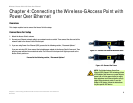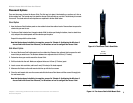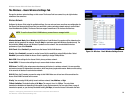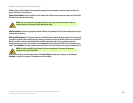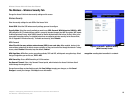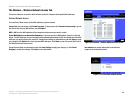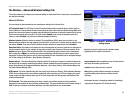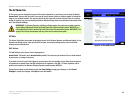
16
Chapter 5: Configuring the Wireless-G Access Point with Power Over Ethernet
The Wireless - Wireless Security Tab
Wireless-G Access Point with Power Over Ethernet
The Wireless - Wireless Security Tab
Change the Access Point’s wireless security settings on this screen.
Wireless Security
Enter the security settings for each SSID of the Access Point.
Select SSID. Select the SSID whose security settings you want to configure.
Security Mode. Select the security method you want to use, WPA-Personal, WPA-Enterprise, RADIUS, or WEP.
(WPA stands for Wi-Fi Protected Access, which is a security standard stronger than WEP encryption. WEP stands
for Wired Equivalent Privacy, while RADIUS stands for Remote Authentication Dial-In User Service.) Refer to the
appropriate instructions below. For detailed instructions on configuring wireless security for the Access Point,
turn to “Appendix B: Wireless Security.” To disable such security, select Disable.
WPA-Personal
Allow PCs with the same wireless network name (SSID) to see each other. When enabled, devices in the
same wireless network will be able to access each other, so they can transfer files through the network. To deny
access, select Disabled. Otherwise, keep the default, Enabled.
WPA Algorithms. WPA offers you two encryption methods, TKIP and AES, with dynamic encryption keys. Select
the type of algorithm you want to use, TKIP or AES.
WPA Shared Key. Enter a WPA Shared Key of 8-32 characters.
Key Renewal Timeout. Enter a Key Renewal Timeout period, which instructs the Access Point how often it
should change the encryption keys.
Change these settings as described here and click Save Settings to apply your changes, or click Cancel
Changes to cancel your changes. Click Help for more information.
Figure 5-5: Wireless - Wireless Security
(WPA-Personal) Screen
encryption: encoding data transmitted in a network.



